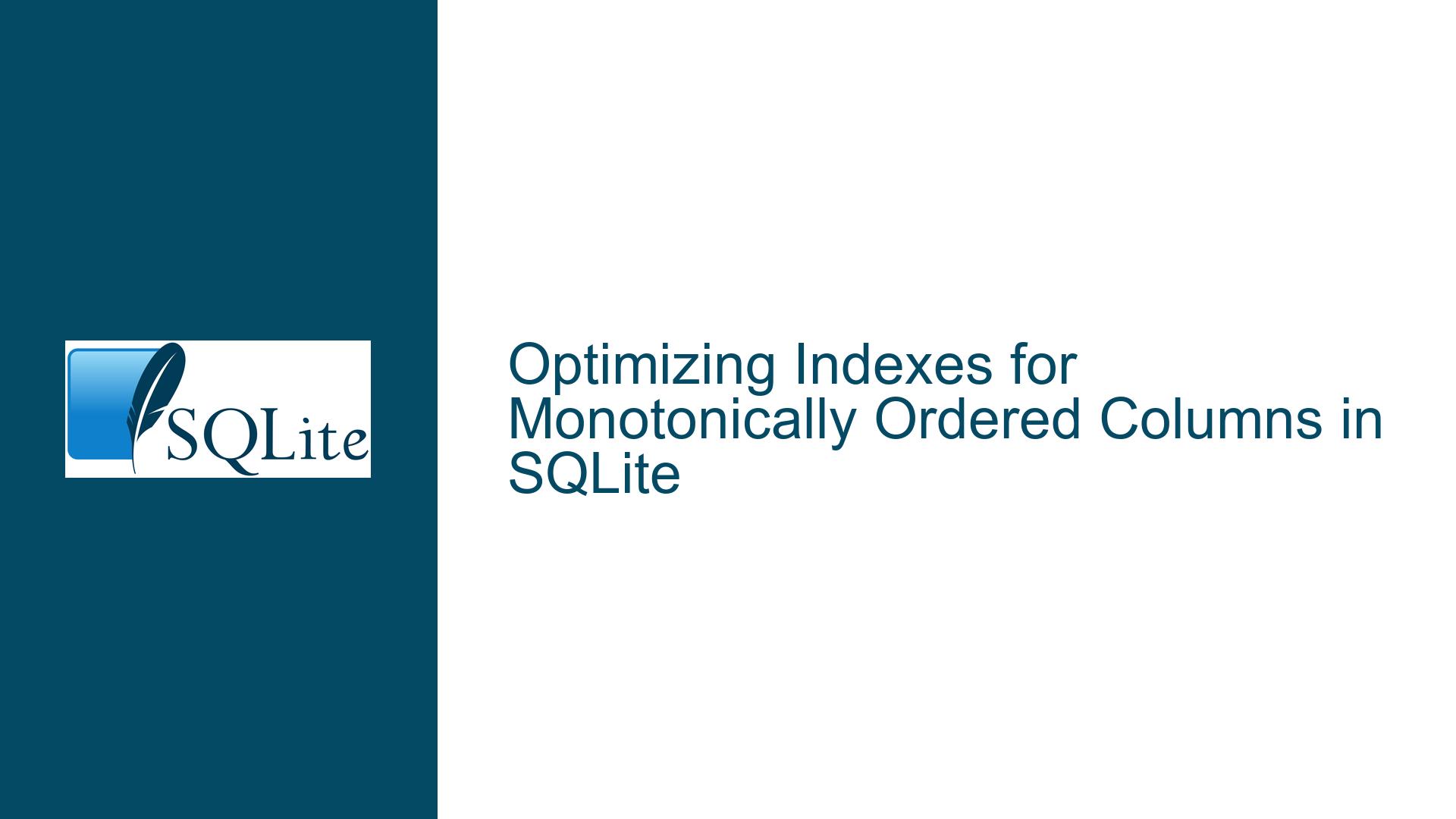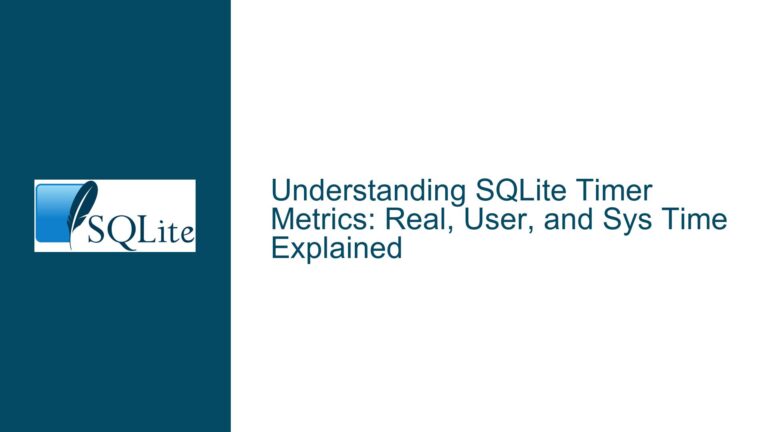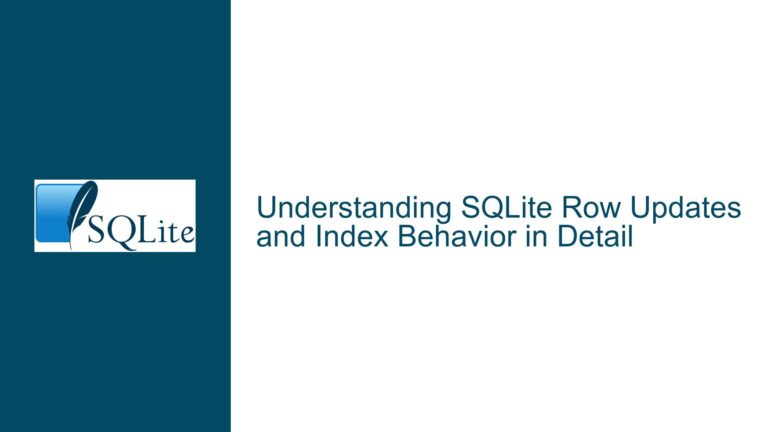Optimizing Indexes for Monotonically Ordered Columns in SQLite
Understanding Monotonic Column Relationships & Index Redundancy
Monotonic columns – where values never decrease (or increase) relative to another column – are common in time-series data, event logs, and sequential records. In SQLite, developers often create composite indexes on combinations like (a,b) and (b,a) to accelerate queries filtering or sorting on either column. However, when column b is strictly monotonic relative to a (e.g., for every a0 < a1, b0 ≤ b1), the (a,b) index inherently encodes ordering information for b due to the monotonic relationship. This creates redundancy when maintaining separate indexes like (b,a), as the (a,b) index could theoretically serve both query patterns. The core issue arises from SQLite’s query planner lacking awareness of monotonic constraints, leading to inefficient index utilization, unnecessary disk space consumption, and suboptimal query performance.
A practical example involves a table storing timestamped data with hierarchical components (hour, minute, second). A composite index on (hour, minute, second) naturally orders all three columns. Queries sorting by hour alone efficiently use this index. However, sorting by minute or second without including hour in the query triggers a full table scan or temporary B-tree construction, despite the inherent monotonic relationship. This inefficiency stems from SQLite’s inability to infer that scanning the (hour, minute, second) index in its entirety would produce a globally ordered sequence of minute or second values due to the monotonicity constraint.
Why SQLite Fails to Leverage Monotonicity in Index Optimization
1. Absence of Declarative Monotonic Constraints
SQLite lacks a mechanism to declare columns as monotonic relative to others. Without explicit metadata, the query planner cannot deduce that an index on (a,b) implicitly orders b in a way that satisfies queries targeting b alone. This forces developers to create redundant indexes (e.g., (b,a)) to cover different query patterns, doubling storage and write overhead.
2. Query Planner’s Reliance on Column Position in Indexes
The query planner prioritizes the leftmost columns of an index for sorting and filtering. For a query ordering by b, the planner will not consider an (a,b) index unless a is constrained in the WHERE clause. Even if b is monotonic relative to a, the absence of a in the query prevents the planner from recognizing that traversing the (a,b) index sequentially would yield the desired order for b.
3. Data Integrity Checks for Monotonicity
Enforcing monotonicity requires runtime validation during INSERT/UPDATE operations. SQLite does not natively support constraints to ensure that b never decreases as a increases. Developers must implement triggers or application-level checks, which adds complexity. Without such enforcement, the assumption of monotonicity becomes a liability, risking incorrect query results if the data violates the expected order.
4. Index Coverage and Virtual Column Tradeoffs
The proposal to mark index columns as "virtual" (storing references instead of values) introduces a tradeoff: reduced index size at the cost of additional disk reads during queries. SQLite’s current indexing model prioritizes covering indexes to minimize row lookups. Introducing virtual columns would require rearchitecting how indexes store and retrieve data, conflicting with existing optimization strategies.
Strategies for Efficient Index Design with Monotonic Columns
1. Leverage Composite Indexes with Implicit Ordering
For a table mono(hourOfDay, minOfDay, secOfDay) with a composite index on (hourOfDay, minOfDay, secOfDay):
- Query:
SELECT * FROM mono ORDER BY hourOfDay, minOfDay;
Optimization: The index is fully utilized because the ORDER BY clause matches the index’s leftmost columns. - Query:
SELECT * FROM mono ORDER BY minOfDay;
Inefficiency: SQLite scans the entire table and uses a temporary B-tree for sorting.
Solution: Rewrite the query to include hourOfDay in the WHERE clause, even with a broad range:
SELECT * FROM mono WHERE hourOfDay BETWEEN 0 AND 23 ORDER BY minOfDay;
This allows the query planner to traverse the index sequentially, leveraging the monotonic relationship between hourOfDay and minOfDay.
2. Eliminate Redundant Indexes via Query Restructuring
If b is monotonic relative to a, remove the (b,a) index and refactor queries to use the (a,b) index:
- Original Query:
SELECT * FROM t WHERE b = ? ORDER BY a;
Revised Query:SELECT * FROM t WHERE a >= (SELECT MIN(a) FROM t WHERE b = ?) AND a <= (SELECT MAX(a) FROM t WHERE b = ?) AND b = ? ORDER BY a;
This uses the (a,b) index to find the range of a values corresponding to b = ?, avoiding a full scan.
3. Implement Application-Level Monotonicity Enforcement
Since SQLite lacks built-in constraints for monotonicity, use triggers to validate data:
CREATE TRIGGER enforce_monotonic_b
BEFORE INSERT ON t
FOR EACH ROW
WHEN EXISTS (SELECT 1 FROM t WHERE a < NEW.a AND b > NEW.b)
BEGIN
SELECT RAISE(ABORT, 'Violates monotonic constraint on b');
END;
This trigger ensures that inserting a row with a greater than existing rows does not result in a lower b value.
4. Use Partial Indexes for Time-Series Data
For tables where monotonic columns represent timestamps, partition data into ranges and create partial indexes:
CREATE INDEX idx_t_current ON t(a, b) WHERE timestamp >= datetime('now', '-30 days');
This reduces index size and maintenance overhead while still leveraging monotonicity within the active data range.
5. Evaluate Alternative Storage Formats
For extreme scalability with monotonic data, consider SQLite’s Virtual Table interfaces to integrate columnar storage or compressed time-series formats. A virtual table can transparently handle monotonicity constraints while using specialized storage engines, bypassing SQLite’s row-oriented limitations.
6. Analyze Query Plans with EXPLAIN
Regularly use EXPLAIN QUERY PLAN to verify index usage:
EXPLAIN QUERY PLAN
SELECT * FROM mono ORDER BY minOfDay;
If the output shows SCAN TABLE mono USING INDEX monoDMS, the index is being used correctly. If it shows USE TEMP B-TREE, revise the query or index structure.
7. Benchmark Index Maintenance Overhead
Compare the performance impact of maintaining redundant indexes versus query slowdowns from full scans. Use SQLite’s sqlite3_analyzer tool to profile index size and usage statistics. For write-heavy tables, eliminating redundant indexes often justifies minor query optimizations.
8. Consider SQLite’s Strengths and Limitations
SQLite excels at embedded, low-concurrency scenarios but isn’t optimized for terabyte-scale time-series data. If monotonic columns dominate your schema and storage efficiency is critical, evaluate hybrid architectures: use SQLite for metadata and recent data, while offloading historical records to specialized systems like TimescaleDB or columnar files.






